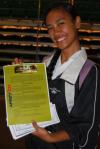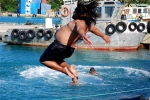- Talia Goldenberg
- Still life. With cat.
The first thing I noticed about Talia Goldenberg was her body – she was showcasing a goodly portion of it and what was on display wasn’t very meaty.
Those two aspects alone were enough to tell me she wasn’t a local. The clincher was that all that bare skin was the colour of fresh milk on a snowy Minnesota morning.
I encountered Talia at the Avarua Wharf. I had ventured there because I was bored at the office. When your contract is nearly up and you’re desperate for a new one, sitting around the office looking bored is not the prescribed method for ensuring future employment.
I was hoping to find local kids leaping from the wharf into the harbour, so I could hand in enough photos – Hey, Look What The Kids Are Up To On Their Summer Holidays! – to fill a page in the Cook Islands Herald.
Instead, I encountered My Fine Young Colleague (MFYC), sitting on the top level of the lone set of bleachers that resides outside Trader Jacks. MFYC is 19 and and model-worthy and eager to embrace all the adventures the future may hold. Everything I’m not, actually.
Talia was sitting on the bottom level of the bleachers, drawing in a sketchpad.
I greeted MFYC and, once I had his attention, indicated the young lady with the pen and paper. He shrugged in a way that told me he didn’t know who she was or what she was up to.
Being the grizzled veteran, I took the lead, sitting down beside the young lady to ask what she was drawing. “Water,” she said, and then introduced herself as Talia Goldenberg, 20, from Portland, Oregon.
I do things like that – march right up to the Talia Goldenbergs of this world – because I am a highly-trained professional journalist and, as such, understand that stories do not drop, neatly wrapped and tied with a bow, on your lap. Sometimes you have to plunk yourself down beside a young lady and go fishing.
It turned out that Talia was one of 25 art students – 21 ladies and the four luckiest lads in the history of the world – from Carleton College who had stopped in Rarotonga for six days en route to New Zealand and, later, Australia. They would spend 10 weeks away from home as part of an art course that would include such topics as drawing from nature and printmaking.
Home – as MFYC and I, now armed with our recording gear, discovered later when we met up with various members of the group at Paradise Inn for a round of interviews – is Northfield, Minnesota.
For what it was worth, I scored some serious brownie points by knowing Northfield was the setting for one of the James-Younger Gang’s heists.
It was at this point, however, that my fear for the future of the world was cemented.
MFYC: What gang?
Me: James-Younger. You know: Jesse James. The bank robber.
MFYC: Wasn’t he married to Sandra Bullock?
Me: Um, actually, I’m talking about the OTHER Jesse James.
MFYC: Never heard of him.
Me: Oh. Dear.
This exchange, conducted in front of Talia and her friends, their faces shiny with pride as they displayed their sketchbooks, was not the first time that day MFYC had demonstrated how big the gulf actually is between baby boomers and whatever generation is just now graduating from high school (iGeneration? Wii Generation?).
Earlier, at the office, MFYC had spotted a pile of LPs on a desk. We’re talking vinyl here, folks, the real deal. Classic with a capital “C.” MFYC held up Hot August Night, Neil Diamond’s live double album that every self-respecting baby boomer played until the needle on their turntable wore down to a nub.
“That, my young friend,” I said, “is one for the ages. They don’t make music like that anymore.”
His brow furrowed. He peered at the image on the front of the dust cover. Then he looked up at me.
“Who,” he asked, “is Neil Diamond?”
The generation gap just widened. If it continues to do so, it may just swallow me completely.






























